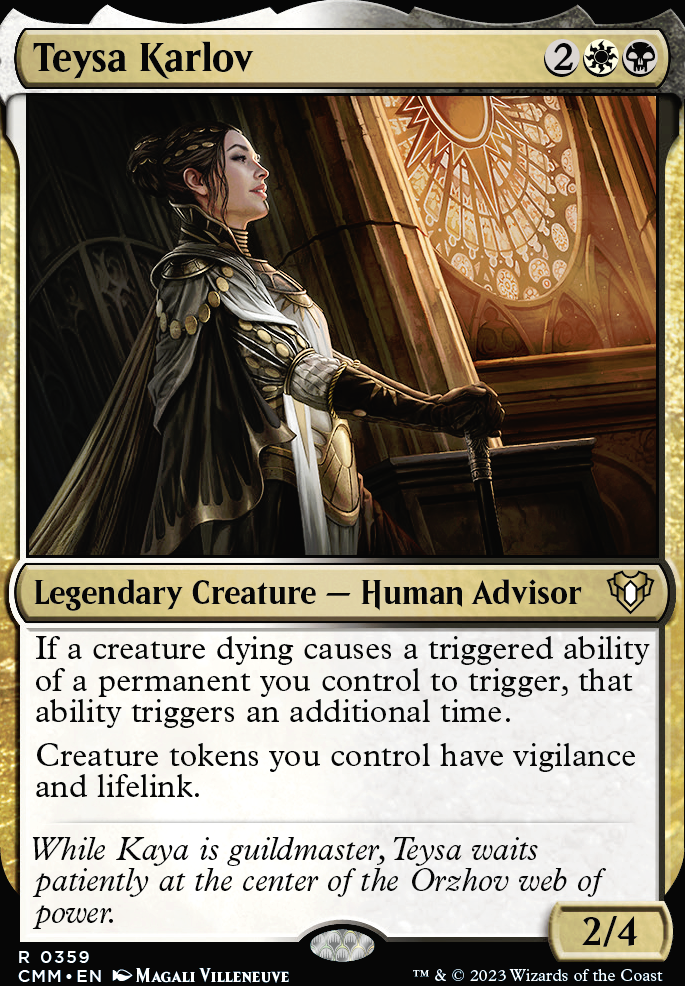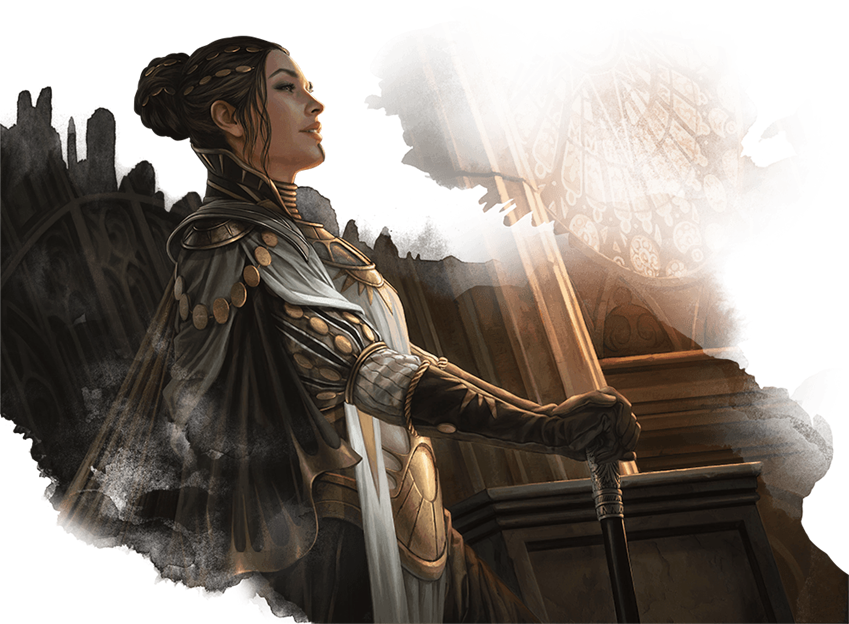
Necronomicon | Teysa Karlov | Primer
Commander / EDH Aristocrats Combo Multiplayer Primer Tokens WB (Orzhov)
Fodder (34)
- 1x Adeline, Resplendent Cathar
- 1x Archivist of Oghma
- 1x Battle Angels of Tyr
- 1x Bennie Bracks, Zoologist
- 1x Black Market Connections
- 1x Blood Artist
- 1x Carrier Thrall
- 1x Carrion Feeder
- 1x Cathar Commando
- 1x Cruel Celebrant
- 1x Deep Gnome Terramancer
- 1x Doomed Traveler
- 1x Elenda, the Dusk Rose
- 1x Esper Sentinel
- 1x Garrison Cat
- 1x Grim Haruspex
- 1x Hallowed Spiritkeeper
- 1x Hunted Witness
- 1x Knight of the White Orchid
- 1x Lotho, Corrupt Shirriff
- 1x Market Gnome
- 1x Midnight Reaper
- 1x Nested Shambler
- 1x Omarthis, Ghostfire Initiate
- 1x Orcish Bowmasters
- 1x Pawn of Ulamog
- 1x Ranger-Captain of Eos
- 1x Reassembling Skeleton
- 1x Recruiter of the Guard
- 1x Solitude
- 1x Stoneforge Mystic
- 1x Urza's Saga
- 1x Viscera Seer
- 1x Zulaport Cutthroat
Control (10)
- 1x Cathar Commando
- 1x Grave Pact
-
1x
Living Death

- 1x Path to Exile
- 1x Solitude
- 1x Tragic Arrogance
- 1x Vanishing Verse
- 1x Vanquish the Horde
- 1x Yawgmoth, Thran Physician
Utility (9)
Land (35)
- 1x Agadeem's Awakening Flip
- 1x Ancient Tomb
- 1x Brightclimb Pathway Flip
- 1x Caves of Koilos
- 1x Command Tower
- 1x Exotic Orchard
- 1x Fetid Heath
- 1x Gemstone Caverns
-
1x
Godless Shrine

- 1x High Market
- 1x Malakir Rebirth Flip
- 1x Phyrexian Tower
- 7x Plains
-
1x
Reflecting Pool

- 1x Scrubland
- 1x Silent Clearing
- 9x Swamp
- 1x Takenuma, Abandoned Mire
- 1x Urborg, Tomb of Yawgmoth
- 1x Urza's Saga
- 1x Vault of Champions
Mana (19)
- 1x Ancient Tomb
- 1x Arcane Signet
- 1x Ashnod's Altar
- 1x Battle Angels of Tyr
- 1x Black Market Connections
- 1x Carrier Thrall
- 1x Chrome Mox
- 1x Deep Gnome Terramancer
- 1x Gemstone Caverns
- 1x Knight of the White Orchid
- 1x Lotho, Corrupt Shirriff
- 1x Mana Crypt
- 1x Orzhov Signet
- 1x Phyrexian Altar
- 1x Pitiless Plunderer
- 1x Smothering Tithe
- 1x Sol Ring
- 1x Talisman of Hierarchy
Sacrifice (10)
- 1x Ashnod's Altar
- 1x Braids, Arisen Nightmare
- 1x Carrion Feeder
- 1x Diabolic Intent
- 1x High Market
- 1x Phyrexian Altar
- 1x Phyrexian Tower
- 1x Plumb the Forbidden
- 1x Viscera Seer
- 1x Yawgmoth, Thran Physician
Drain (4)
Commander (1)
Death Trigger (20)
- 1x Blood Artist
- 1x Carrier Thrall
- 1x Cruel Celebrant
- 1x Doomed Traveler
- 1x Elas il-Kor, Sadistic Pilgrim
- 1x Elenda, the Dusk Rose
- 1x Garrison Cat
- 1x Grave Pact
- 1x Grim Haruspex
- 1x Hallowed Spiritkeeper
- 1x Hunted Witness
- 1x Luminous Broodmoth
- 1x Market Gnome
- 1x Midnight Reaper
- 1x Nested Shambler
- 1x Omarthis, Ghostfire Initiate
- 1x Pawn of Ulamog
- 1x Pitiless Plunderer
- 1x Skullclamp
- 1x Zulaport Cutthroat
Draw (14)
- 1x Archivist of Oghma
- 1x Battle Angels of Tyr
- 1x Bennie Bracks, Zoologist
- 1x Black Market Connections
- 1x Braids, Arisen Nightmare
- 1x Esper Sentinel
- 1x Grim Haruspex
- 1x Midnight Reaper
- 1x Necropotence
- 1x Plumb the Forbidden
- 1x Skullclamp
- 1x Stoneforge Mystic
- 1x Yawgmoth, Thran Physician
Recursion (6)
Maybeboard
Death Trigger (49)
- 1x Abyssal Gatekeeper
- 1x Ancient Stone Idol
- 1x Ashen Rider
- 1x Athreos, God of Passage
- 1x Boreas Charger
- 1x Carrier Thrall
- 1x Cathodion
- 1x Corpse Augur
- 1x Dead Man's Chest
- 1x Demon of Dark Schemes
- 1x Desperate Sentry
- 1x Dire Fleet Hoarder
- 1x Doomed Dissenter
- 1x Dusk Urchins
- 1x Dutiful Attendant
- 1x Erebos, Bleak-Hearted
- 1x Falkenrath Noble
- 1x Gate to the Afterlife
- 1x Hangarback Walker
- 1x Harvester of Souls
- 1x Imperious Oligarch
- 1x Kokusho, the Evening Star
- 1x Lightning Coils
- 1x Martyr's Bond
- 1x Massacre Wurm
- 1x Matter Reshaper
- 1x Ministrant of Obligation
- 1x Nether Traitor
- 1x Nim Deathmantle
- 1x Ogre Slumlord
- 1x Open the Graves
- 1x Orzhov Enforcer
- 1x Overseer of the Damned
- 1x Pious Evangel Flip
- 1x Revel in Riches
- 1x Roc Egg
- 1x Rotlung Reanimator
- 1x Seraph of the Scales
- 1x Sifter of Skulls
- 1x Teysa, Orzhov Scion
- 1x Thornbite Staff
- 1x Tithe Taker
- 1x Treasure Keeper
- 1x Twilight Drover
- 1x Vindictive Lich
- 1x Vindictive Vampire
- 1x Wurmcoil Engine
- 1x Xathrid Necromancer
- 1x Yosei, the Morning Star
Draw (17)
- 1x Dawn of Hope
- 1x Dead Man's Chest
- 1x Demonlord Belzenlok
- 1x Dusk Urchins
- 1x Erebos, Bleak-Hearted
- 1x Harvester of Souls
- 1x Krav, the Unredeemed
- 1x Land Tax
- 1x Matter Reshaper
- 1x Mentor of the Meek
- 1x Phyrexian Arena
- 1x Priest of Forgotten Gods
- 1x Smothering Abomination
- 1x Treasure Keeper
-
1x
Tymna the Weaver

- 1x Verge Rangers
- 1x Village Rites
Ramp (7)
- 1x Boreas Charger
- 1x Cathodion
-
1x
Crypt Ghast

- 1x Keeper of the Accord
- 1x Priest of Forgotten Gods
- 1x Sifter of Skulls
- 1x Smothering Tithe
Buff (5)
Tokens (35)
- 1x Ancient Stone Idol
- 1x Ayli, Eternal Pilgrim
- 1x Bitterblossom
- 1x Carrier Thrall
- 1x Dawn of Hope
- 1x Desperate Sentry
- 1x Elspeth, Sun's Champion
- 1x Endrek Sahr, Master Breeder
- 1x Field of Souls
- 1x Ghoulcaller Gisa
- 1x Grave Titan
- 1x Hangarback Walker
- 1x Imperious Oligarch
- 1x Keeper of the Accord
- 1x Lightning Coils
- 1x Martial Coup
- 1x Minion Reflector
- 1x Ministrant of Obligation
- 1x Ogre Slumlord
- 1x Open the Graves
- 1x Ophiomancer
- 1x Orzhov Enforcer
- 1x Overseer of the Damned
- 1x Regna, the Redeemer
- 1x Roc Egg
- 1x Secure the Wastes
- 1x Seraph of the Scales
- 1x Spirit Bonds
- 1x Teysa, Orzhov Scion
- 1x Tithe Taker
- 1x Twilight Drover
- 1x Westvale Abbey Flip
- 1x Woe Strider
- 1x Wurmcoil Engine
Sacrifice (25)
- 1x Altar of Dementia
- 1x Attrition
- 1x Blasting Station
- 1x Cartel Aristocrat
- 1x Eldrazi Monument
- 1x Erebos, Bleak-Hearted
- 1x Fanatical Devotion
- 1x Final Payment
- 1x Fleshbag Marauder
- 1x Ghoulcaller Gisa
- 1x Krav, the Unredeemed
- 1x Merciless Executioner
- 1x Minion Reflector
- 1x Pious Evangel Flip
- 1x Plaguecrafter
- 1x Priest of Forgotten Gods
- 1x Sadistic Hypnotist
- 1x Smothering Abomination
- 1x Spawning Pit *list*
- 1x Spirit Bonds
- 1x Westvale Abbey Flip
- 1x Whisper, Blood Liturgist
- 1x Woe Strider
- 1x Yahenni, Undying Partisan
Drain (13)
- 1x Aetherflux Reservoir
- 1x Blasting Station
- 1x Debt to the Deathless
- 1x Exquisite Blood
- 1x Exsanguinate
- 1x Falkenrath Noble
- 1x Kokusho, the Evening Star
- 1x Massacre Wurm
- 1x Palace Siege
- 1x Pious Evangel Flip
- 1x Sanguine Bond
- 1x Vindictive Vampire
- 1x Wound Reflection
Combo With Untap (1)
Teysa Orzhov Scion Combo (1)
Recursion (29)
- 1x Adarkar Valkyrie
- 1x Animate Dead
- 1x Athreos, God of Passage
- 1x Bloodghast
- 1x Brood of Cockroaches
- 1x Cauldron of Souls
- 1x Coffin Queen
- 1x Debtors' Knell
- 1x Demon of Dark Schemes
- 1x Dread Return
- 1x Dutiful Attendant
- 1x Enduring Renewal
- 1x Karmic Guide
- 1x Lifeline
- 1x Mikaeus, the Unhallowed
- 1x Palace Siege
- 1x Rally the Ancestors
-
1x
Ravos, Soultender

- 1x Reanimate
- 1x Reveillark
- 1x Sheoldred, Whispering One
- 1x Shirei, Shizo's Caretaker
- 1x Sigil of the New Dawn
- 1x Sun Titan
- 1x Sword of Light and Shadow
- 1x Thrilling Encore
- 1x Tortured Existence
- 1x Victimize
- 1x Whisper, Blood Liturgist
Control (26)
- 1x Angelic Purge
- 1x Ashen Rider
- 1x Attrition
- 1x Austere Command
- 1x Ayli, Eternal Pilgrim
- 1x Crush Contraband
- 1x Demon of Dark Schemes
- 1x Doomskar
- 1x Elspeth, Sun's Champion
- 1x Final Payment
- 1x Fleshbag Marauder
- 1x Hour of Revelation
- 1x Kaya's Guile
- 1x Kaya's Wrath
- 1x Martial Coup
- 1x Merciless Eviction
- 1x Merciless Executioner
- 1x Mortify
- 1x Overseer of the Damned
- 1x Plaguecrafter
- 1x Priest of Forgotten Gods
- 1x Return to Dust
- 1x Sheoldred, Whispering One
- 1x Teysa, Orzhov Scion
- 1x Utter End
- 1x Vindicate
Utility (15)
- 1x Academy Rector
- 1x Gate to the Afterlife
- 1x Minion Reflector
- 1x Mother of Runes
- 1x Nether Traitor
- 1x Open the Armory
- 1x Sadistic Hypnotist
- 1x Shadows of the Past
- 1x Stoneforge Mystic
- 1x Sword of Light and Shadow
- 1x Teferi's Protection
- 1x Tithe Taker
- 1x Vault of the Archangel
- 1x Weathered Wayfarer
- 1x Yawgmoth's Will
Other (6)
Suggestions
Updates Add
Comments View Archive
Attention! Complete Comment Tutorial! This annoying message will go away once you do!
Important! Formatting tips — Comment Tutorial — markdown syntax
Please login to comment
| Top Ranked |
|
| Date added | 5 years |
| Last updated | 1 year |
| Legality | This deck is not Commander / EDH legal. |
| Rarity (main - side) | 18 - 0 Mythic Rares 39 - 0 Rares 18 - 0 Uncommons 9 - 0 Commons |
| Cards | 100 |
| Avg. CMC | 2.39 |
| Tokens | Construct 0/0 C, Copy Clone, Eldrazi Scion 1/1 C, Eldrazi Spawn 0/1 C, Human 1/1 W, Human Soldier 1/1 W, Manifest 2/2 C, Morph 2/2 C, Orc Army, Shapeshifter 3/2 C, Soldier 1/1 W w/ Lifelink, Spirit 1/1 W, Squirrel 1/1 G, Treasure, Vampire 1/1 W |
| Folders | Jennifer, Stuff I like, Teysa, Primers, cool ideas, EDH References, New decks, Decks, Favorite Decks, EDH |
| Votes | |
| Ignored suggestions | |
| Shared with | |
| Views |





